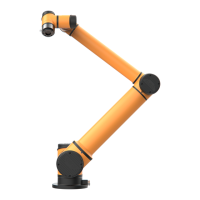
Do you have a question about the AUBO AUBO-i10 and is the answer not in the manual?
Introduces safety principles and norms for robot operation, emphasizing adherence to manual descriptions.
Defines danger levels and symbols used throughout the manual to ensure safety awareness.
Provides essential safety precautions for protecting users and preventing machine damage during operation.
Outlines integrator responsibilities for risk assessment and adherence to relevant safety standards.
Identifies potential hazards and misuse between robot and operator for risk assessment.
Defines the industrial purpose of the robot and lists impermissible uses and applications.
Covers emergency stop devices, recovery procedures, and excessive force protection mechanisms.
Outlines the basic sequence for installing the AUBO robot system components.
Lists essential safety conditions and precautions to be observed during robot installation.
Discusses defining the robot's working space and mechanical dimensions for safe operation.
Covers the installation of the manipulator base, its structure, and mounting.
Details the mechanical structure of the end-effector flange and cable connection procedures.
Introduces the control box, its power, and electrical warnings for safe operation.
Describes the front, side, and back panels of the control box, including switches and interfaces.
Explains how to select between Manual and Linkage working modes for the robot system.
Highlights essential electrical warnings and cautions for system design, installation, and service.
Details Ethernet, Modbus RTU, and USB interfaces for connecting external devices.
Explains the dual-channel safety I/O design and its functions for operational safety.
Provides a step-by-step procedure for installing the robot body, control box, and teach pendant.
Guides users through the correct procedures for powering on and off the robot system.
Details the sequence for quickly starting the robot system after installation.
Introduces the teach pendant's operation interface, including login and main screen.
Explains how to control robot movement and position using the teach pendant interface.
Describes how to view and configure the robot's electrical input/output settings.
Covers setting the initial robot pose and calibrating tool kinematics and dynamics.
Details configuration of safety parameters like collision class, reduced mode, and reset.
Covers general system settings for language, date/time, network, password, and updates.
Explains how to add extensions like Modbus devices, vision systems, and camera plugins.
Introduces the programming interface and its components like menu bar and toolbar.
Covers creating, loading, saving, and managing projects and program files.
Explains the use of procedures and subprojects for program structure and reusability.
Details different motion command types like Joint, Line, and Track for robot movement.
Describes basic commands (Loop, Break) and advanced commands (If-Else, Switch).
Explains how to define and use variables and timers within programming.
Covers using the simulation model and configuring scripts for programming.
Lists key technical specifications including model, weight, payload, and dimensions.
Details the input/output ports, power supply, communication, and interface specifications.
Provides a comprehensive list of alert codes, error descriptions, possible errors, and solutions.